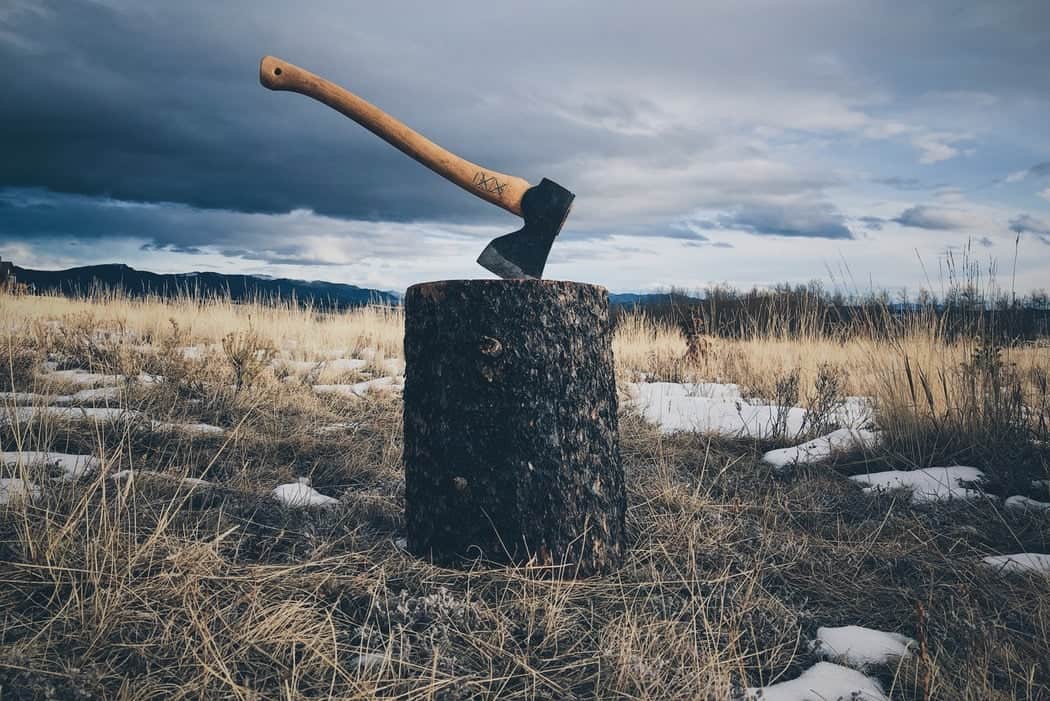Bushcraft axes offer more uses than just chopping up firewood and limbing trees. For example, some of the vastly varied design tools out there are made from a material known as high-carbon steel that can be used to get a spark from flint and start a fire.
Originally the purpose of these axes was to assist in all facets of survival. So whether you need to go out and start splitting wood or logs, or you just want to get warm and start a fire to hunt game for dinner, this tool will have your back. These simple tools were born out of necessity, and slowly their designs changed and adapted with curved handles for speed or blunter axe heads for precise deep cuts.
Many of those for sale right now can also be used in place of knives and hammers, severely lowering the amount of extra weight and equipment you have to carry with you while out in the wild. The axe can really be a multipurpose tool if you know how to use it properly, that is.
In the wilderness, where you are alone with nature, there is no tool better than a bushcraft axe to use for all things, from hammering tent pegs into cutting strips of fabric, whittling wood, or chopping it up for your bonfire at night.
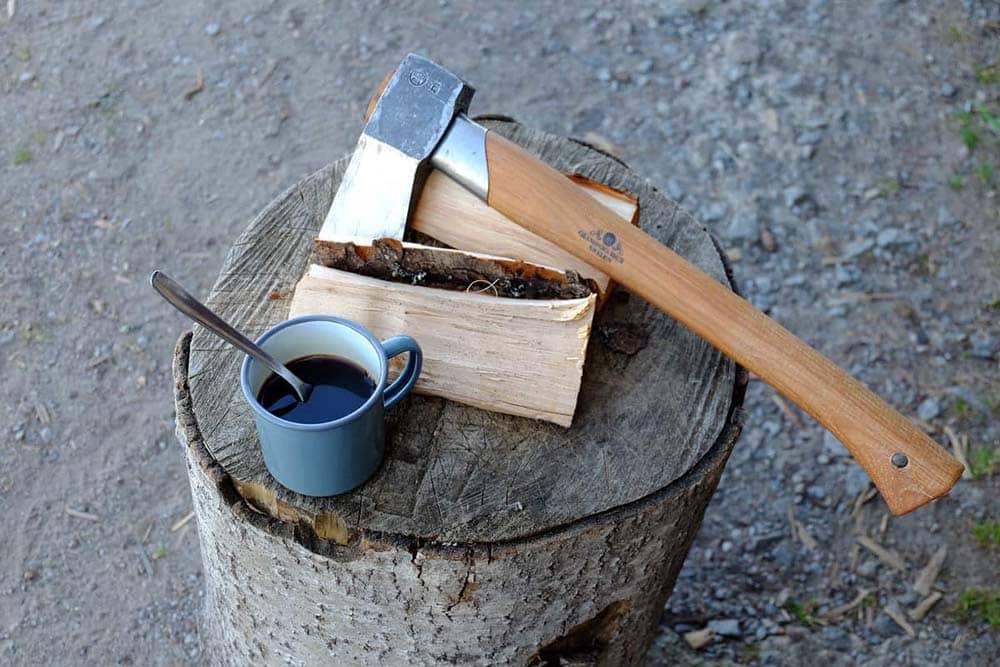
Why just not carry a bigger one, then? Although bigger tools can be used similarly, their weight is a significant drawback, thus making them much more cumbersome, so they are not nearly as refined and easy to use with one hand and take a lot of effort to carry with you on your travels. So, for something easy to use and transport while still being a very functional and useful tool, look carefully through this comprehensive guide to let me help you choose your next best tool.
1. SOG Camp
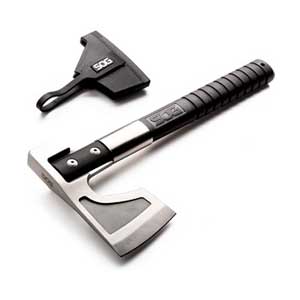
The new SOG Camp Axe features a nicely constructed Stainless Steel blade in a compact size that makes it a great companion that is lightweight enough to be carried on your belt while also being useful enough to accomplish any task you need, be it felling, splitting or chopping wood. And yes, you can throw it.
The Camp is weighted very nicely and gives a predictable rotation, so it’ll work. If you are somewhat into throwing axes or blades, this hatchet won’t give you much of a problem.
This item measures 11.5 inches tip to tail, and its weight is only 16.10 oz. The blade is 3.1 inches and, thankfully, comes with a sheath to keep the blade and you protected. The Sheath is made out of the same nylon-reinforced glass that the handle itself, so you really are getting some quality materials here. It fits perfectly over the blade and snugs nicely right on without falling off. Additionally, the sheath has a rubberized strap that wraps around the back of the axe so that it will be tightly secured.
Though the handle isn’t made out of the best material out there, which is wood, there aren’t any vibrations transmitted through the reinforced nylon handle. It is also quite sturdy and feels great in hand when chopping, however. The one thing that I would like is that SOG would add a little bit more thickness to the handle.
Though I haven’t tested it to its breakpoint, the stainless steel blade seems pretty tuff. After repeated throws and chops and general fooling around over the last couple of days, I can assure you that this handle is very stable for something made out of synthetic materials.
Although you can certainly chop through some larger trees, smaller ones are where this tool is best at. It’s balanced nicely, but it doesn’t have the weight of a full-sized one; therefore, you will not get the deep cutting you might expect with a swing from a full-sized axe.
This item can do almost anything, from chopping up precut firewood into smaller pieces and cutting off smaller branch limbs to clearing an area to hammer in tent stakes. It also excels at chopping off foliage, branches/small brush from larger branches so you can gather material for a temporary shelter.
This Camp Axe from SOG is a great little tool to have with you in the field and an awesome addition to your camping gear. It’s well-made and sturdy, and the compact footprint makes it great to take along with you on camping trips. I can say with a hand on my chest this may be the best Bushcraft axe on the market right now.
Pros
- The new SOG Camp Axe features a nicely constructed Stainless Steel blade in a compact size that makes it a great companion that is lightweight enough to be carried on your belt
- The Camp is weighted nicely and gives a predictable rotation, so it’ll work. If you are somewhat into throwing axes or blades, this hatchet won’t give you much of a problem
- This ax is capable of doing almost anything, from chopping up precut firewood into smaller pieces, cutting off smaller branch limbs to clearing an area to hammer in tent stakes
Cons
- The ax’s head isn’t smooth all the way, and when trying to chop almost anything, it will get stuck, interrupting anything you are currently doing just to try to pull it out
- While the handle is definitely pretty durable, it isn’t that good at conducting energy without gloves, and the cheap plastic makes it feel very uncomfortable after using it for too long
2. Gransfors Bruk Wildlife Hatchet
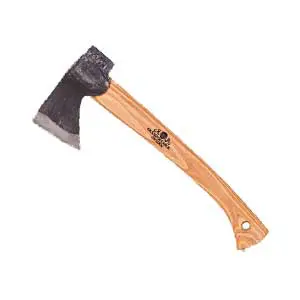
This second bushcraft axe from Gränsfors Bruks is exceptionally lightweight at only 1.3 pounds in total; however, it does have somewhat of a diminished head shape and overall cutting edge. The handle of the Gränsfors is designed with an impressive curve and is made from oil-hardened hickory wood, meaning this tool offers an impressive amount of swing with a powerful cutting force for clearing branches and cutting smooth edges into wood designs.
The Gränsfors Bruk is also small enough to use in your hand, much like the way you would use a pocket knife for finer details; the head is forged from high-grade Swedish steel, which is extremely strong and offers long-lasting durability, why also not having an immense weight. Additionally, it’s a highly suggestive metal and, therefore, the most easily sharpened.
The total handle length of the Gränsfors is 12 inches, meaning this one will fit very comfortably on your hip or in a bag with little extra bulkiness or weight. The purchase of the Gränsfors comes with a vegetable-tanned sheath that’s very adjustable and made specifically to protect those who do decide to hip-carry rather than pack the axe head.
The steelhead of the Gränsfors Bruk is uniquely integrated around the wood handle rather than on top, making this product last long because the fit will stay tighter over time. It has a very short handle length – 12 inches which would be easy to carry. It is made from hand-forged Swedish steel, which weighs 1.3 total pounds. But heads may come off-center and need re-centering before use. The blade folds over pretty easily and needs sharpening.
The handle of the Gränsfors features a rough slippery finish which will need to be sanded off to get the best material for your grip. Suffice it to say this one can pack quite a punch without having much weight behind it, allowing you to do simple actions like splitting and felling without much problem. So, I would say that this model is an excellent choice and even ahead of some of the American competition.
Pros
- The handle of the Gränsfors is designed with an impressive curve and is made from oil-hardened hickory wood, giving it a very good-looking and premium feel without lowering its usability
- This ax offers an impressive amount of swing with a powerful cutting force for clearing branches and cutting smooth edges into wood designs, making it a tool for both heavy-duty and finer work
- Additionally, it’s a highly suggestive metal and, therefore, the most easily sharpened, meaning that maintaining it even in the field will be a smooth and easy process
Cons
- While Gransfors advertise their sheet as an excellent way to protect your ax and a very durable case, its actually super thin and cheaply made, most of the time being delivered with the ax head poking out if
- The actual head is very good, being made with a huge amount of craftsmanship, but the ax itself is so crooked that it will crack the handle if there is too much force put into it. And while this is not always the case, there have been too many reports of this problem
3. Hults Bruk Foresters Premium
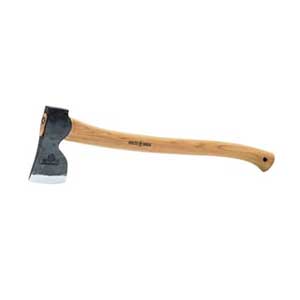
The Hults Bruk Akka Forester’s Axe is now a part of my everyday assortment of tools, whether on the job or in the woods.
For the professional on the job site, this model is your go-to root and brush cutting tool with a lot more class than others. For the carpenter who prefers hand tools over power tools, it will help you through the rough cutting processes until you’re ready for the detailed work. For the outdoorsman, it’s an indispensable tool for everything from trail clearing to fire and game prep. As a tool, it’s extremely versatile, and it’s made from very high-grade steel.
The style of the Akka and history behind Hults Bruk make it a piece you’ll be proud to own and should stand the test of time to be passed on to the next generation. The Akka falls in the premium category, so expect to pay a little bit more, but you also get a very high-end leather sheath. In my opinion, this is a great choice for anyone interested in the art of bushcraft.
Pros
- For the carpenter who prefers hand tools over power tools, it will help you through the rough cutting processes until you’re ready for the detailed work
- For the outdoorsman, it’s an indispensable tool for everything from trail clearing to fire and game prep, and it’s an extremely versatile piece of gear made from very high-grade steel.
- Each ax comes with a traditional leather protective sheath that is embellished with some unique Swedish decorative elements, giving you a bit more flare
Cons
- The ax suffers from one major problem – there is so much work put into it looking good that the sheet that comes with it is better looking than most other items, but this style is at the cost of the usability of the ax, making it more of a showpiece than a tool you will be using daily
- The grind of the ax isn’t well made and, most of the time, is crooked to the opposite direction, and the handle isn’t well balanced, resulting in high pressure being put on one point until won’t day it snaps in knots
4. Estwing Sportsman’s
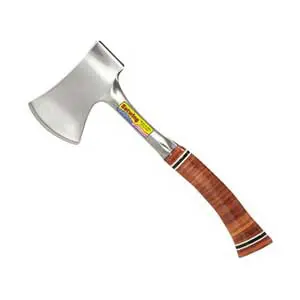
The last product on our list is the Estwing 14-inch Sportsman’s Axe. The manufacturer, Estwing, is a popular American company for producing unique, durable hatchets and tools, with the 14-inch Camping Hatchet as one of the most loved and adored by users. It has garnered a long list of positive reviews from users who were satisfied with its quality.
If you’re a tradesman or carpenter, you’ve probably been looking forward to owning this Estwing piece. If you ask us which of the products from the list offers great value, it’s definitely this one as it’s the lowest price but works as good as high-end bushcraft axes and hatchets.
The Sportsman Axe of Estwing is popular for lots of reasons. Among them is its one-piece forged steel construction that allows you to eliminate the need to handle replacements under normal circumstances. It comes with a steel handle wrapped using stacked leather, which gives you a comfortable yet strong grip.
Despite having an all-steel construction with a leather grip, its weight is only under a pound. Its narrow head comes with a cutting edge that measures 3.25 inches. It has made its way to our list despite its unique design because its sharpness holds surprisingly well. It requires minimal dressing. As for its cheeks, they’re quite thin. All in all, it’s lightweight, comfortable, and easy to use and transport.
It’s also a great camping hatchet, as it comes with a leather sheath that has a belt slot. Even though it lacks a hickory handle, the Estwing Sportsman’s is one that we can say is of great quality. It has the excellent cutting ability, and it’s practically indestructible. We liked it a lot, and we’re sure you’ll also love it.
The only thing we’ve seen off-putting with this item is its steel handle. The shock from striking or wood splitting will be transferred into your hand, but we’ve found that it’s not excessive. It’s best if you only use it for a short period of time. If you need it to work for hours, then the issue can be easily fixed with the addition of a leather handle wrap. As for its strength, you won’t have any problem in that department with this as it’s strong enough even for serious cutting jobs.
Pros
- Its one-piece, forged steel construction allows you to eliminate the need to handle replacements under normal circumstances and gives it even better energy transfer and overall rigidity and strength of the whole tool
- It comes with a steel handle that’s wrapped using stacked leather, which gives you a comfortable yet strong grip on the ax, and also makes it look a bit better
- Despite having an all-steel construction with a leather grip, its weight is only under a pound, and its narrow head comes with a cutting edge that measures 3.25 inches, giving you a lot of cutting potential
Cons
- Unlike the handle, the sheet is made from a much worse piece of leather, and the whole process of putting it on is so complicated and cumbersome that you can easily cut yourself when trying to put it on
- While the handle is certainly very comfortable and good-looking, the polished leather is so slippery that using the ax properly for heavy-duty work will be very hard
5. Schrade SCAXE2
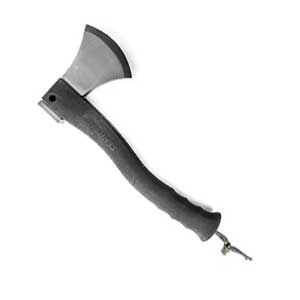
This axe is perfect for those looking to buy the best product at a low price. While its price tag is one of its main selling points, it’s also quite an effective bushcraft instrument. At 15 inches and under 2 pounds, it is compact and transportable, as traditional bushcraft should be, with low weight and a comfortable handle.
The blade is made from strong 3Cr13 stainless steel and coated with titanium. The black glass fiber-filled PA handle has an ergonomic rubber grip, and the rod has lanyard holes. The axe also comes with a polyester belt sheath.
While the Schrade Survival Axe lacks some of the premium features of more expensive competitors, such as hickory handles, higher-grade steel, and fine, hand-forged craftsmanship, it is still a very good choice. This one is ideal for starting fires and occasional light woodwork and can be held with either one or two hands, depending on the task at hand and the power needed.
This stainless steel coated in titanium axe, while susceptible to scratching, retains its sharpness for a long time and can definitely get the job done. While it may not be the quality of a Grӓnsfors Bruks model, this axis is certainly up to the test and can go a long way for a reasonable price.
Pros
- While its price tag is one of its main selling points, it’s also quite an effective bushcraft ax, having decent quality and lots of features even though its pretty budget
- At 15 inches and under 2 pounds, the ax is compact and transportable, as traditional bushcraft should be, with low weight and a comfortable handle
- The blade is made from strong 3Cr13 stainless steel and coated with titanium, giving the cheap steel not only a premium look but also some bonuses like more rigidity, strength, and durability
Cons
- While most of the sheats here have been kinda crappy, this plastic one is worse because you can at least sew up a nylon one, but after the plastic one breaks in a couple of days, that’s it
- The Ferro rod has been advertised as a huge addition to the ax and a very useful feature, but it is so poorly secured that after only a couple of swings, it will fall out
6. Council Tool Velvicut
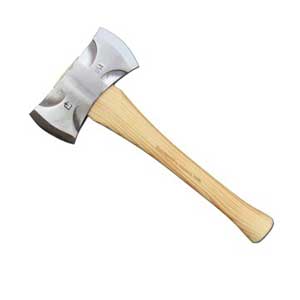
This Council Tool masterpiece is built for the grind and wear and tear of heavy work. Produced by Council Tool, a trusted tool manufacturer for over 125 years, the Velvicut Premium Saddle Axe is a versatile instrument designed to be both multifunctional and easily transportable. This specific design received its name from being traditionally carried on horseback. The axhandle is made of American hickory, the preferred wood for the purpose, and has a 16-inch “pre-hanging” height and a 15-1/2-inch “post-hanging” height.
The Council Tool Velvicut is renowned for its heat-treated and -tempered 5160 carbon steel blade, a long and sharp metal with a very long lifespan. The Council Tool axe has two blades. The left blade has an incredibly sharp 25-degree flat grind, making it perfect for shaving and carving, and the right blade has a blunter 32-degree flat grind, which is more appropriate for heavier jobs such as chopping or splitting wood.
In line with its name, this axis is as premium as it gets. Aside from a superior blade and beautifully crafted hickory handle, the Velvicut model comes with a fine leather double-bit blade cover. Note that this premium quality comes at a premium price.
Pros
- The Velvicut Premium Saddle Axe is a versatile ax designed to be both multifunctional and easily transportable, with its compact and lightweight design
- This specific design received its name from being traditionally carried on horseback, and has been made for over 125 years, so with that much heritage, you know it carries quality with it
- The Council Tool Velvicut is renowned for its heat-treated and -tempered 5160 carbon steel blade, long and sharp metal with a very long lifespan
- The Council Tool ax has two blades – the left blade has an incredibly sharp 25-degree flat grind, making it perfect for shaving and carving, and the right blade has a blunter 32-degree flat grind, which is more appropriate for heavier jobs such as chopping or splitting wood.
Cons
- The biggest gripe with this particular model is its handle because, in most cases, the grain on the handle is very poorly finished, and when that isn’t true, it’s probably cracked in the middle, making the whole product practically unusable
7. Hults Bruk Jonaker Hatchet
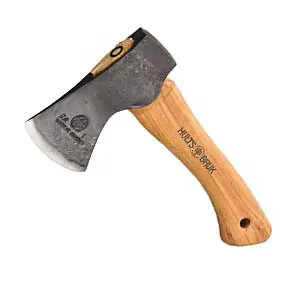
When it comes to the Jonaker, there’s no question about it; it’s one of the nicest hatchets I’ve ever seen. Beyond the beautiful dark brown leather sheath reveals a solid Swedish carbon steel head with a one-pound weight. Below, you’ll find a stunning and incredibly easy-to-grip, Linseed oiled and hand-sanded, curved American hickory handle.
While reviewing the Jonaker hatchet outdoors, I was pleasantly surprised by how such a small piece of gear could be indispensable. From kindling to light clearing and building my shelter, this hatchet made easy work of it all.
The compact size makes this hatchet perfect for a lifetime of backpacking to hunting, camping, and beyond. You can bet it will go with me in just about every pack I load out. After seeing the performance and durability firsthand, this is one piece of gear I absolutely love!
For such a finely made tool, taking care of it will be at the top of my priority list of things to do. If you’re considering a Holts Bruk axe, hatchet, etc., find someone who knows how to sharpen it if you can’t. Once a year or so, treat it to a few drops of raw linseed oil where the hickory passes through the eye.
Pros
- This ax features an excellent, stunning, and incredibly easy to grip, Linseed oiled and hand-sanded, curved American hickory handle.
- The compact size makes this hatchet perfect for a lifetime of backpacking to hunting, camping, and beyond, not to mention its lightweight body, which makes it very easy to be carried around
- This ax is built in such a way that using it as a multipurpose tool will be super easy, from kindling to light clearing and building my shelter, this hatchet made easy work of it all
Cons
- This hatchet is advertised as a premium model, but most of the time, you will find pieces of unfinished metal protruding from its head, making it not only unpleasant to look at but also showing how much quality control there is
- For a hatchet that banks so heavily on its good looks and aesthetics, the engravings and the seals of quality on the ax have been so neglected that most models look like they’ve been used for months, even though they are brand new
8. Karesuando Stuorra Hatchet
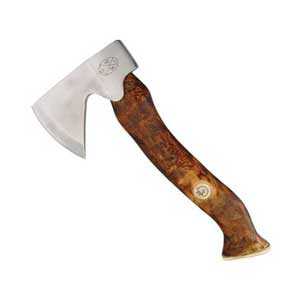
From Karesuando Knives comes the Stuorra Aksu Big Axe Hatchet, a stunning hatchet with an oiled curly birch and reindeer antler handle and a satin-finish, stainless steel head. It measures 11.5 inches with a 5 inches head and a 3.5 inches blade.
Unlike most competitors, this hatchet uses its bigger size as an advantage, not a detriment. Its big and easy-to-grip handle is much easier to grip than metal and polymer ones, and the nice finish gives it a quality and premium feel in your hand without feeling too heavy and cumbersome. The blade is reasonably thick, with a perfectly positioned drop that allows you to use your tool for everything, not only chopping and splitting.
Suffice it to say, if you want a pretty compact but still big enough to use with two hands hatchet at a reasonable price while still having quality materials, this should already be in your cart.
Pros
- Unlike most of its competitors, this hatchet uses its bigger size as an advantage, not a detriment, to give it even more durability, more cutting potential because of the bigger head, and more powerful swings overall because of the meatier handle
- Its big and easy to grip handle is so much easier to grip than metal and polymer ones, and the nice finish gives it a quality and premium feel in your hand without feeling too heavy and cumbersome
- The blade is reasonably thick, with a perfectly positioned drop that allows you to use your ax for everything, not only chopping and splitting
Cons
- From the cheek forward, the head is warped to the left (looking back to front) about 3/16 to 1/4 inch, resulting in the entire cutting edge being offset that much
- While defects are a bit less common in this model, the return policy is so bad that it costs you 20% of the purchase for them even to consider returning it
9. CRKT Kangee Tomahawk
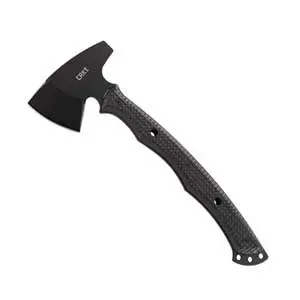
Yes, I know I show you a lot of CRKT axes. No, I don’t work for them or promote them for profit. They just make some quality stuff that also looks really good.
They also have some great unique designs created by very experienced makers from around the country. If you were wondering, CRKT stands for “Columbia River Knife & Tool.”
You remember when I mentioned I like longer handles and find hatchets obsolete….well that’s not always true. This is a perfect example of when it’s not true. I love the design it is another by Elmer Roush, it makes me think of a modern take on ancient stone axes.
The hatchet weight is only 1lbs 2.3 oz, measuring 11.25 inches. If you could carry only one small ax for a wilderness excursion, this would be the one for me.
It takes up very little pack space, adds very little weight for such an item, and above all, it’s useful. It has a slight beard to it giving you more cutting edge, it has an elongated neck that boosts chopping power, and for its small size, it still has a decent little pole.
All that in one tiny 1060 high carbon steel package, sitting atop an American Hickory handle. I will say the steel quality is a tad lower than I’d like to see; however, it’s not a dealbreaker negligible just want something small and light for “just in case” this is the one for you.
Pros
- The ax’s weight is only 1lbs 2.3 oz and measuring to a mere 11.25 inches, making it a perfect small and compact tool to carry with you in the wilderness
- The blade uses some very high-quality materials, like its 1060 high carbon steel for an even sharper, lighter edge and an American Hickory handle for some style combined with functionality and durability
- Тhere is also a very useful feature where you can option a spike on the opposite edge of the ax’s head, giving it even more functions like the ability to break the glass during an emergency
Cons
- While the handle of the ax is pretty durable, the edge of the head is so brittle that even a frozen piece of meat can put some dents into it, not even mention harder trees that can be fatal
- The brittleness of the edge also affects the uppermost point of the head, and like many customers have reported, even after only minutes of testing, a large piece can just break off
What Features To Consider When Choosing The Best Bushcraft Axe?
The following headings ask each of the important questions you will be searching for in a bushcraft hatchet, helping you to choose your busy for confronting mother nature.
What Is The Optimal Length?
It’s unlikely that you will drag a 36-inch axe with you into the wild because, let’s be honest, you can’t attach something of that size onto your belt, thus making it practically useless in most Bushcraft scenarios.
Size plays a tremendously important role and actually greatly defines what makes a bushcraft tool. The size, though, is something that isn’t only a variable to the handle – its head can be of a varying size too.
The length of a powerful bushcraft hatchet will determine whether you can cut down a larger tree or not, and in the cold, this really does matter because the bigger the log, the better fuel you are going to get. So, we are ruling out hatches in the cold areas because while their pocket size is a good thing in most areas here, it is to your detriment.
What you want is for something to be anywhere between 12 to 20-inches because axes of this size offer an excellent level of portability while still having enough area for grip when you need to take down some bigger trees.
What Is The Optimal Weight?
You don’t necessarily want something super light because, after all, this is the main reason most tools aren’t able to make deep cuts. But you also don’t want a head that weighs higher than three pounds, so around 2 is the best middle ground. Not only will it be light, but also useful. These medium ones are useful not only for finer jobs but for thicker trees too, so felling or splitting wood won’t be much of a problem while being small enough to pack the tool into your bag.
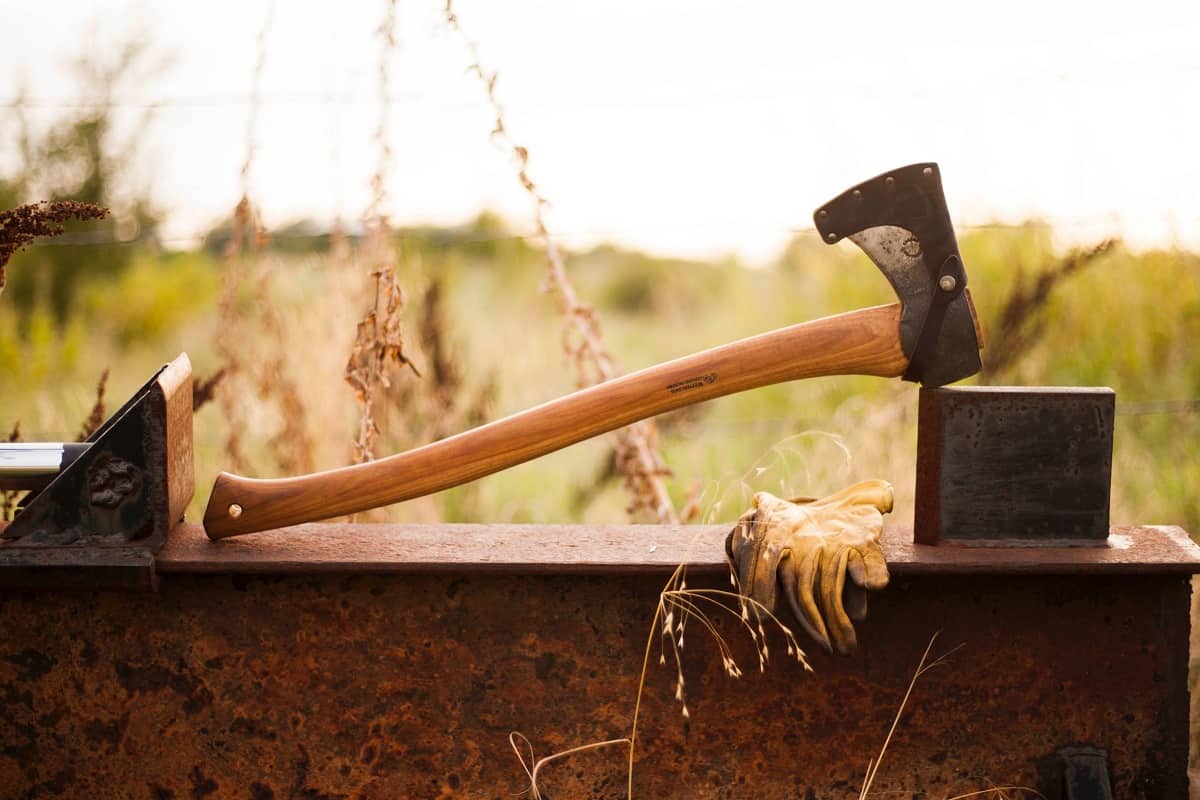
What Is The Optimal Material?
Like all tools out there, the material that they are built from determines many of their prime characteristics, like durability, use, weight, and so on and so on. But here, I’m going to narrow down the best ones for both the handle and the head of the axe.
What Is The Optimal Handle Material?
Wood, there is nothing better, something like ash or hickory is the best, with the latter being preferred even by European makers. Those woods are very shock resistant and also feel extraordinary in the hand.
I’m not the biggest fan of polymer handles for several reasons. Not only do they not feel as friendly to your skin, but if they break, you can’t replace the handle with a piece of branch around you. Metal handles are generally too heavy for exploring the woods while also being very prone to transmitting the reverberations from a strike into your hands, so preferably stay away from them
In my honest opinion, nothing can beat the best old hickory handle coated with linseed oil. It will survive numerous years, and it feels shockingly good in your hand, trust me.
What Is The Optimal Blade Material?
Though you may think that choosing the right steel alloy down to its molecular structure or production number is the most important thing, the quality of your blade is far more dependent on how much craftsmanship was put into it.
Forged Scandinavian steel is the best, followed by vintage American Northeast axes.
The Scandinavian countries have a concept called “everyman’s right,” which is the freedom to roam, so they do put some serious work into making the best Bushcraft equipment out there, and despite the introduction of chainsaws, the highest-quality axe heads still come from those countries.
Now, let’s talk a little bit about the other contender here – the good old USA. Well, here, axe blades are of high quality, they aren’t even a close match to Scandinavian ones. They are much more poorly quality controlled, with less effort and craftsmanship put into them, resulting in an overall worse cutting experience.
What Is The Optimal Price Tag?
Depending on the materials used, the price for an axe typically increases, especially for the best survival hatchets, which are hand forged and made with high-quality curved handles. But don’t go out worrying yourself that a hatchet will leave a large dent in your pocket because even the simplest of falling axes is more expensive than the best Bushcraft ones, so you won’t be needing to fork out a lot of money.

What Is The Proper Grip?
Hatchets offer a single-handed grip which makes it easier to handle them for cutting and whittling, but the varnish grip can vanish with prolonged use, resulting in a slippery and unstable one.
If your axe comes with a slippery varnish, I suggest sanding it off to make the handle easier to hold on to. More friction equals more control.
Some bushcraft tools offer single grips, but typically these are long enough to require a double-handed grip, which, while limiting mobility and speed, greatly increases the power of your swing.
What Sheath To Choose?
All the axes on this list come with superior sheath guards to protect your tool from growing dull or picking up rust and to protect you, of course. The best ones are made out of leather and treated with quality vegetable oil.
What Is The Proper Warranty?
For the highest level of protection against manufacturing defects, make sure you choose an axe with a superior warranty. Some models out there come with a proper 20-year warranty, so don’t worry about little errors.
Frequently Asked Questions

What Are The Most Common Bushcraft Axes Types?
There are many different parts and features to an axe, so it can not only be a jack of all trades but also a single-minded and purpose tool tailor-made to be the best at a certain task.
So, to clear things up a little bit, I’m going to go through all of the most commonly used types out there, listing all of their uses and pros and cons.
What Is A Hatchet?
A hatchet is usually a shorter axe with a handle 18″ long or shorter. Their head weighs about one to a half pounds, making them much easier to handle.
They are designed for one-handed use, often for light chopping and splitting purposes and general camp chores such as hammering tent pegs or starting a fire.
Hatchets often have a hammerhead on the poll, but some people may say that this feature makes it not an axe, though I disagree.
If there’s no broad, flat area with which to strike, then you’ve got more of a hand axe than a hatchet.
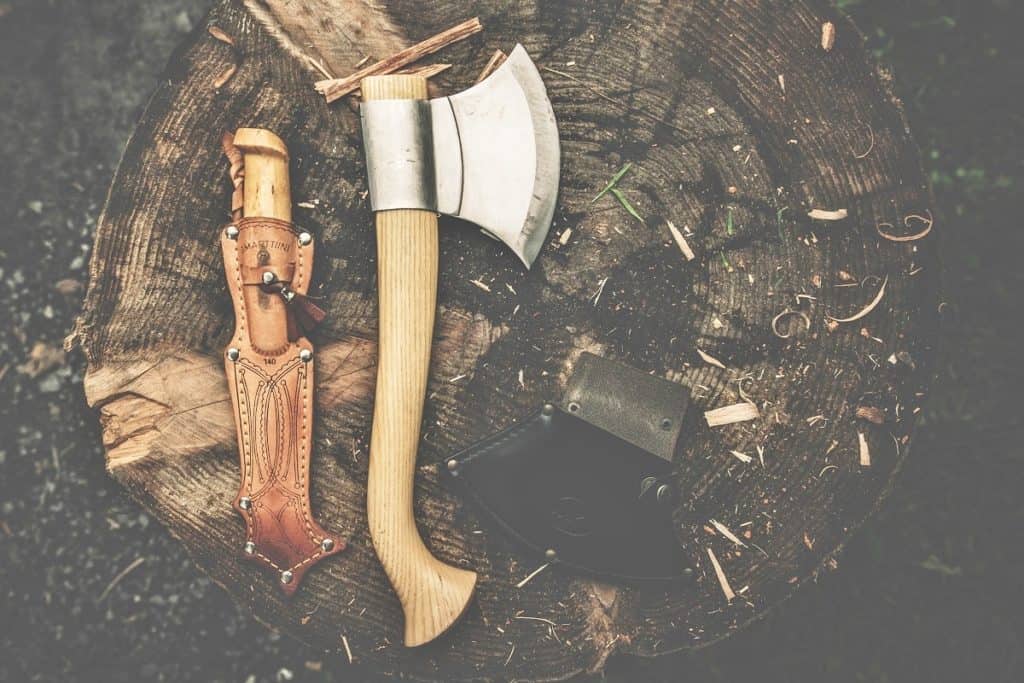
What Is A Felling Axe?
Also called a cutting axe, these are designed for chopping into wood across the grain. They have thin cheeks to bite deeply and a lighter heads for making faster and more pronounced swings.
So, felling axes are best for chopping trees down as well as cutting up logs. Though, take note, they aren’t that good at splitting them.
Felling axes are quite big, often having a 28-32″ long handle and a head that weighs usually around three pounds, so don’t expect the lightness of a hatchet here.
What Is A Splitting Axe?
A splitting axe has a deeper level and wider cheeks than the felling one, so the head pushes apart logs as you slice through the grain, thus making it a lot better for acquiring wood supplies.
Some even have specially-designed cheeks that curve out like a wedge. Splitting axes have a handle about 32-36″ long and weigh anywhere from four to a whopping seven pounds.
What Is A Double Bit Axe?
Early American woodsmen often spent a long time in the woods, chopping wood to help them hang on a little bit longer in this new land. And with their experience, they thought, why carry more equipment than necessary?
So, they took the felling and splitting axe, combining them into a double-headed one.
Sometimes called a Michigan axe, a double-bit axe may be a bit heavier and more awkward to carry than a single one, but you save a lot of weight from carrying two separate tools. But since it replaces two full-size axes, it isn’t really perfect for bushcraft.
What Is A Limbing Axe?
Anybody who’s worked in the woods knows that tree limbs love to get in the way. That’s why the axe designed to clear limbs is small and light enough to help you clear the path to your goal.
Limbing ones are often a foot shorter than the felling, at 24″ long, and have a head that weighs 2 pounds, so they are somewhat of middle ground when it comes to size.
What Is A Boy’s Axe?
If a limbing axe is 2/3rd the size of most chopping ones, then a boy’s axe is 3/4th the size of your average felling items. A boy’s handle is normally 28″ long, and the head weighs somewhere between two pounds and something. The head profile is often halfway between cutting and splitting items profiles, so you’ve got a pretty decent mix of the two
These may be smaller than an “adult” one, but they are still ready to pull some punches while still shaving some, in my opinion, unnecessary weight.
What Is A Forest Axe?
Though the name may sound a little stupid, forest axes are intended for people exploring the woods on foot who may need to process some wood rather than professionals who need the best tools and can deal with bulk.
The Forest tools, therefore, have short handles of 19″ to 24″ and a multipurpose head that, while very useful in many different situations, is a bit heavier, so it is the type of axe that is average at everything while not excelling at anything at particular.
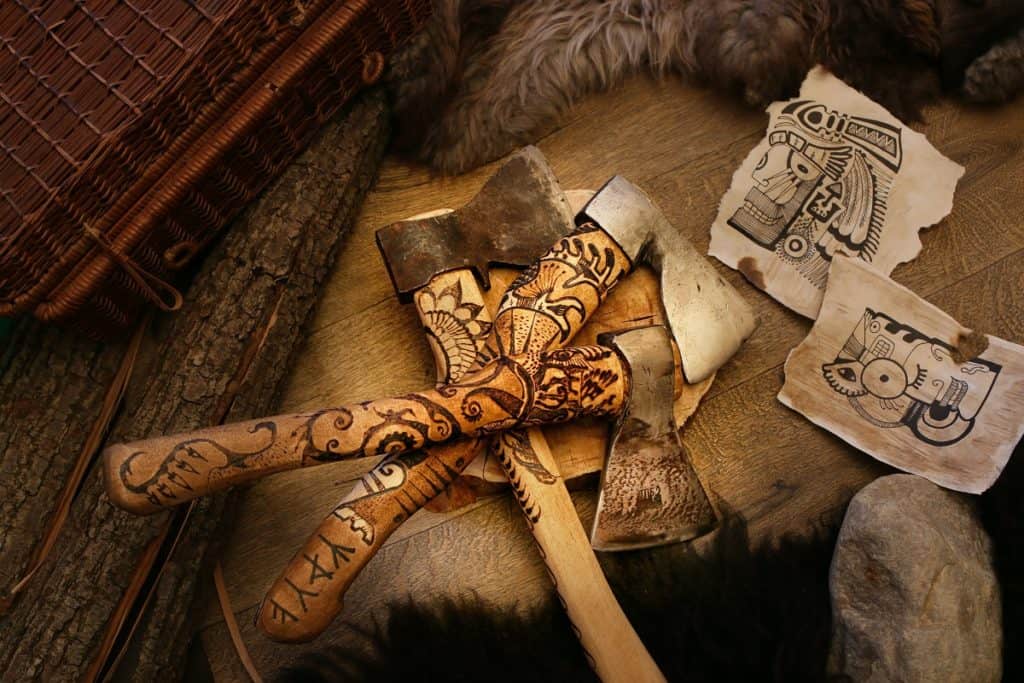
What Differs Tomahawks And Axes?
If you have listened to at least a bit in history class, you’ve probably heard about one of our Native American’s signature weapons – the tomahawk. While on the surface, they may look pretty similar to each other, they actually have a few differences.
Tomahawks are one-handed axes, sometimes with a hammerhead, so that you may be asking yourselves – why not use one of these to help with your bushcraft adventures?
Well, to start, tomahawks are weapons foremost and tools second.
The problem lies in the tomahawk’s head. It’s lighter, with much thinner cheeks. Thinner even than the thinnest cutting axe, the two sides are typically parallel until the metal reaches the eye.
You lose cutting potential because they aren’t backed up by enough weight, and not to mention that because of their small cheeks, you can forget about any splitting. The blade doesn’t push the halves apart, so the whole thing is useless in this category.
That said, tomahawks are best for carving, processing meat, and throwing, so it’s not a bad idea to carry one with you anyway.
Don’t even think about “tactical” tomahawks because those ‘hawks are for posers, not serious users.
How To Use Your Bushcraft Axe Properly?
Bushcraft axes are designed to help a person survive in the most daring situations by using all of the resources mother nature can offer. Of course, at its lowest level, this means getting firewood.
Some basic tips for cutting wood are choosing your mark where you want to chop. Then you need to get the angle of the head right, approximately 30 degrees away from the wood. Now, swing your arm in a 2-foot radius along the angle and keep chopping until you’ve cut the piece of wood. Not only will this general cutting knowledge ensure a smooth precise cut and quicker work, but you will also be safer.
Splitting wood is very similar, though since it’s no longer rooted from the ground, you’ll want to set your logs on top of a surface that keeps them stable while you’re cutting – we suggest a large stump that is preferable as straight as possible. First, place the log on the stand lengthwise, then take your mark near the middle of the log, and raise it above your head before swinging.
Burying the hatchet deep is all that matters when you make your cut because from there, you can hammer both the axe and attached log down on the chopping block until the log splits in half. Chopping blocks are also very important to use because if you ever miss your cut, a chopping block will catch a glancing blow, thus preventing the tool from hitting you.
Another use for your bushcraft axe is getting rid of pesky ice or snow or as a defensive weapon; the sharp head offers heavy hits which can slice to the bone and even break it. So, now that you know how useful it is to have a bushcraft axe beside you, let’s look at some features that define the term “the perfect bushcraft axe.”
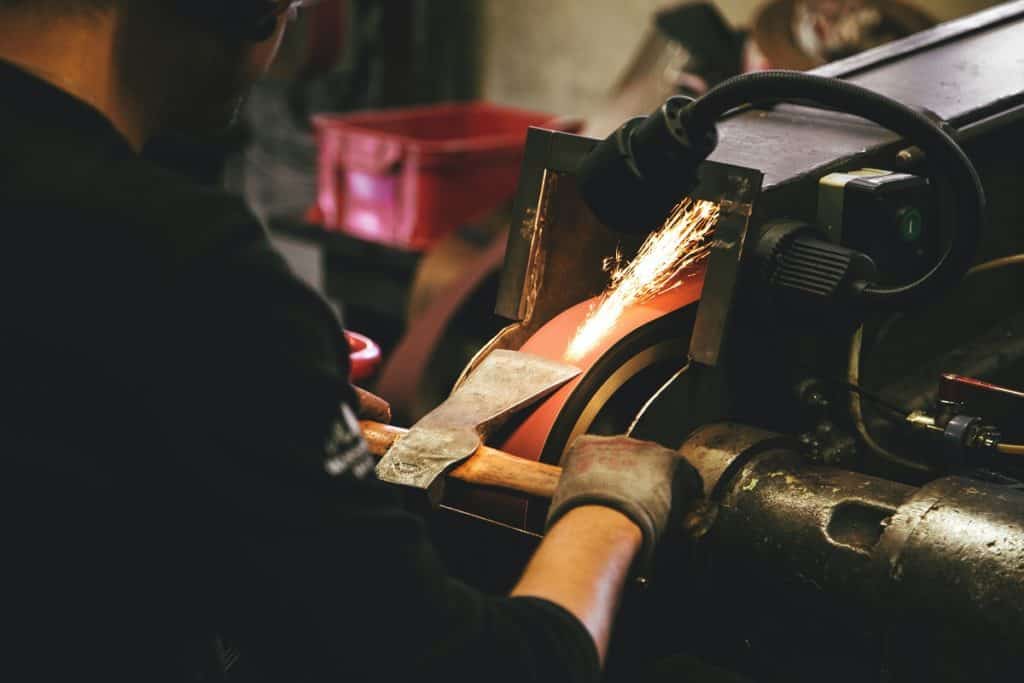
How To Sharpen A Bushcraft Axe?
Before we begin, prepare yourself with these things: a piece of leather, a file, and maybe a whetstone.
Also, make sure you’ve recently cleaned the dirt and other imperfections from your whetstone and file. For chips and nicks in your taxes that have altered the original edge, you’ll need to eliminate some really bad divots to perfect the cutting edge and restore your tool’s cutting potential.
Starting with a metal file is advisable before moving to a whetstone, however, remember that sharpening a hatchet or an axe is a whole different story from sharpening a knife. Smaller whetstones and sharpening stones are ideal for hatchets, whereas bigger ones are for axes.
Beginning with the file, start filing forward away from the handle and off the face of the axe until you remove those bad indentations on either side. Next, it will be up to the sharpening stone to great rid of the smaller chips from the edge – work the edge in small circles on its angle, over and over again, until you’ve removed and smoothed out those dents on both sides.
The last step in the entire process is to lay flat the leather and run your axe against its surface. You’ll see that this removes the burr and further perfects and protects the now-sharpened head.
How To Carry Bushcraft Axe On A Camping Trip?
Always double-check that the sheath is over the head before you start traveling, this is essential for your safety and for protecting the axe from the elements or falling and being damaged by the ground.
Final Words
The best bushcraft axe is a mixture of high-quality materials for the handle and head along with a comfortable and lightweight design which increases the axe’s usability, durability, swing speed, and cutting ability.
But at the end of the day, the best Bushcraft axe for you is the one that you have with yourself on hand, no matter what kind of tool it is – a high or a low-quality one, a normal or a pack, a hatchet or one for felling trees, they just need to be lightweight and made with craftsmanship, nothing more, nothing less.
While design, power, and material are all important things, they are irrelevant in most real-life situations, where you don’t need an expensive brand name like Gransfors Bruk or SOG, or a leather sheath and a carbon steel head, in this situation, you will need skill and quality the most. You just need to make sure that you’ve made an informed choice and that you’ve got a powerful tool to split logs, one for felling trees and chopping wood, something that can be so diverse that it can be used for both from a Bushcraft artisan and a normal carpenter.
If you have anything you want to add, leave a reply down below!

